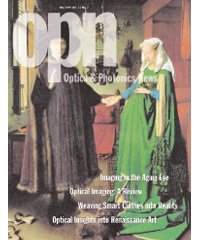
July 2000 Issue
Feature Articles
Retinal imaging encompasses a number of techniques, all with differing goals. The main applications include characterizing the basic anatomy and physiology of the retina, understanding vision changes caused by aging or disease, discovering disease mechanisms, and providing improved care for patients with sight-threatening disease. Since the eye offers the clearest view of living human neural tissue and blood circulation, emerging techniques use the eye as a window to the health of an individual. In recent years, modern photonics have led to advances in each of these areas, although no single technique is optimal for all applications.
by Ann E. Elsmer, Andreus Remky, Joseph Walker, Glenn Wing, Paul Raskauskas, Donald Fletcher, Fletcher, Linda Kelley and Cheryl KieselYou can see a lot by looking – (Yogi Bera). This aphorism captures the power and appeal of imaging: through the visualization of the structure or function of the object of our interest, we can learn a great deal about it. Modern imaging technologies are advancing rapidly, and are becoming important in biology, medicine, and numerous other areas of science. There are many approaches to imaging, each with its own advantages and limitations of targets and of spatial and temporal resolutions. These approaches include magnetic resonance imaging (MRI), positron emission tomography (PET), magnetoencephalography (MEG), optical imaging, ultrasound imaging, and various types of microscopy, including both light and electron microscopy. In this review we shall briefly sketch one particular approach to imaging: optical imaging. We shall illustrate its use in the study of the functional organization of the mammalian brain. A more comprehensive review of optical imaging as applied to the brain can be found in Grinvald et al., 1999.
by Ehud Kaplan, A.K. Prashanth, Cameron Brennan, Lawrence SirovichWeaving Smart Clothes into Reality
The idea behind smart clothes is to give the user the ability to access and process information anywhere at any time. The “clothing” consists of miniature cameras concealed in eyeglass frames, monitors in lenses, transducers in shoes, microphones, and sensors to monitor everything from respiration to skin temperature.
by Susan M. ReissOptical Insights into Renaissance Art
In this feature, world-renowned artist David Hockney and University of Arizona optical sciences professor Charles Falco explain how Hockney’s observation that certain Renaissance paintings seemed almost “photographic” in nature led them to launch an inquiry into the possibility of finding scientific evidence that some of the Old Masters relied on optical aids. Hockney’s visual observations received scientific validation when application of basic optics principles to a number of Renaissance paintings began generating remarkably consistent results.
by David Hockney and Charles M. Falco

![Manual probe system with needles for test of semiconductor on silicon wafer. [A. Morozov / Getty]](https://opnmedia.blob.core.windows.net/$web/opn/media/images/articles/2025/1125/departments/202511-cover-web.jpg?ext=.jpg)
![Researcher Clara Saraceno in the lab. [Image by Carsten Behler Photography]](https://opnmedia.blob.core.windows.net/$web/opn/media/images/articles/2025/1025/departments/202510-cover-web.jpg?ext=.jpg)
